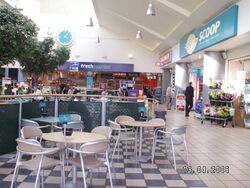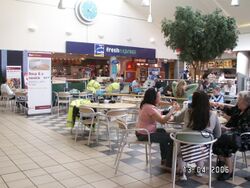History of Doncaster (North) services

Some of the original Moto brands in the services.

There was a long history of attempts to build a service station on the M18. The short-lived Humberside County Council were very concerned that their corner of the motorway network had no motorway service areas anywhere near it.
When one tried to be built to the south of M18 J5 at Hatfield, there was no interest from any operators. The land north of M18 J6 was examined in 1986. It looked like the Department of Transport were ready to try the Hatfield plan again in 1990, but before they could make any progress, their responsibility for building new service areas ended.
Welcome Break were interested in the area but they proposed building at J5. They called it 'Hatfield North'. This didn't happen, and in 1994 another developer turned attention to Rossington Hall (at J3).
We did receive an enquiry as to why the final name chosen was "Doncaster (North)". There is no particular policy behind it, it's just the people involved at the time wanted to name it after somewhere bigger than Hatfield, but they thought they couldn't get away with calling it just "Doncaster".
The Previous Plans
See also: M18 Planning Applications
In 1996, Granada purchased Forte, and the J5 Hatfield plan stayed with them even after they sold Welcome Break. One of Granada's documents, dated September 1996, still had Welcome Break's logo on it.
Granada's first plan would have had the access road run in a straight line, down to a small roundabout. On the left was the petrol station, HGV parking was straight ahead, and on the right was the car and coach parking, with the amenity building and a separate 40-bedroom Travelodge behind it. Space was left for what was called the Hatfield Link Road, but that road would have gone right through the middle of the site, and lorry drivers would have been expected to walk across it.
Those problems were fixed with a new external layout dated 1998, which is very similar to what was built. The first drawings had a very different amenity building. The entrance would have been in the middle of a long corridor, with Travelodge on the far left, and five retail units, plus the game arcade, arranged in a row. At the other end was a Burger King seating area, with toilets on one side and a Little Chef behind it.
Documents also reveal a sketch of another option, undated, which is similar to that one. This would have had an entrance to an area with five retail units around it. Straight ahead were a set of doors leading to a landscaped area with two water lakes. Inside, to the left of the entrance, was the access to the Travelodge which overlooks one of the lakes. On the right was a corridor running past the game arcade, to the Burger King seating area. At the back was the Granada-branded shop, to the right were the toilets, and on the far left was a Little Chef. This seating would have overlooked the other lake. This design is very similar to Stafford, which received praise when it opened in 1996.
In time, those retail units would have become the takeaway outlets we are used to today, but at the time Granada were expecting them to work like a small shopping centre. What is odd about these options is catering would have been provided by only Burger King and Little Chef, making it just a bigger example of the Little Chefs Granada were still building across the country. The designs appear to have been rejected because Granada wanted to make the dining area the focal point of the building.
The chosen design was put forward later in 1998. A balancing pond by the Travelodge causes a small stream to flow around the front of it, like a moat. Space was left for two more buildings to be added to the Travelodge. Approximately 258 parking spaces were provided, with space to expand the car park past the Travelodge. There were 81 HGV spaces and 18 coach spaces. Inside, Little Chef was swapped for Fresh Express.
Opening and Brands

This was Granada's next service area to built after Donington Park, where Granada famously launched their 'village by the roadside' and 'shopping centre' concept. In practice, this meant the building would have a dining area in the centre of an atrium, with a choice of shops built around it. It's a tall building with a single entrance and light entering from the front and along the roof.
While the hotel wasn't fully integrated into the building like it was at the Donington 'village', the two buildings are still interconnected. Granada called it their "flagship" site which will "become an important part of the local community". Staff were paid up to £4.75 an hour (worth around £9 in 2025).
Doncaster had one of the last remaining trucker's cafés on the motorway network. Unlike a traditional transport café it was part of the main amenity building, but still remarkable when it closed in 2009. Next to it was a T2 store, which lay empty for a while, became a games arcade, and is now a Costa. The unit at the front-left served as seating for most of its life, but is now Greggs.
On the right, the Burger King hasn't moved, but WHSmith has replaced Scoop. In front of it was the first games arcade, which became a Costa and is now part of the extended retail area. M&S was first planned in 2009, to open at the front, but was postponed until March 2016 when it replaced EDC. This leaves Burger King and Costa as the main catering providers.
New Road Layout
After a long wait for funding to be provided, the Hatfield Link Road was eventually formally completed in January 2021, and for its opening it was given a predictable bland title, namely 'Unity Way'. A new 'start of motorway' sign was produced and placed on the new dual carriageway as it leaves the new roundabout, but the sign had to be taken down within a few months because the motorway actually begins at the other end of the road.
This is because that was the point where the service area's private land used to join Highways England's motorway land, and when Doncaster Council interfered with the road layout, they opted not to change that arbitrary point. This creates the unusual situation where anybody is allowed to drive, cycle or ride a horse up the new dual carriageway, but only permitted motorway traffic is allowed to exit it at the other end.
Meanwhile, the new road markings and road signs both suggest that the designers are expecting the majority of traffic leaving the service area to be heading for the new B1538 rather than the two motorways, as this is what receives the most space. It's not clear if this was another error or an intentional reflection on how popular modern service area facilities (mainly the coffee shops) can be with local traffic.
The council's concept drawings show the service area being surrounded by new industrial estates both to the west and to the north. While the additional traffic may sound like good news for Doncaster services, such a large employment area may well attract additional facilities that end up taking away more custom than it provides.